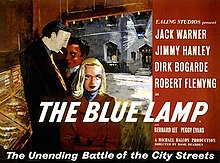The Blue Lamp
| The Blue Lamp | |
|---|---|

UK original quad format film poster
|
|
| Directed by | Basil Dearden |
| Produced by | Michael Balcon |
| Screenplay by | T.E.B. Clarke |
| Starring |
Jack Warner Jimmy Hanley Dirk Bogarde Robert Flemyng |
| Music by |
Ernest Irving Jack Parnell (uncredited) |
| Cinematography | Gordon Dines |
| Edited by | Peter Tanner |
|
Production
company |
|
| Distributed by | General Film Distributors |
|
Release date
|
|
|
Running time
|
85 minutes |
| Country | United Kingdom |
| Language | English |
The Blue Lamp is a 1950 British police drama, directed by Basil Dearden and starring Jack Warner as veteran PC Dixon, Jimmy Hanley as newcomer PC Mitchell, and Dirk Bogarde as hardened criminal Tom Riley. The title refers to the blue lamps that traditionally hung outside British police stations (and often still do). The film became the inspiration for the 1955–1976 TV series Dixon of Dock Green, where Jack Warner continued to play PC Dixon until he was 80 years old (even though Dixon's murder is the central plot of the original film).
The screenplay was written by ex-policeman T. E. B. Clarke. The film is an early example of the "social realism" films that emerged later in the 1950s and 1960s, but it follows a simple moral structure in which the police are the honest guardians of a decent society, battling the disorganised crime of a few unruly youths.
The action mostly takes place in the Paddington area of London, and is set in July 1949, a few years after the end of the Second World War. PC George Dixon (Warner) a long-serving traditional "copper" who is due to retire shortly, takes a new recruit, Andy Mitchell (Hanley), under his aegis, introducing him to the easy-going night beat. Dixon is a classic Ealing "ordinary" hero, but also anachronistic, unprepared and unable to answer the violence of Tom Riley (Bogarde). Called to the scene of a robbery at a local cinema, Dixon finds himself face-to-face with Riley, a desperate youth armed with a revolver. Dixon initially tries to talk Riley into surrendering the weapon, but Riley panics and fires. Dixon is taken to hospital, but dies some hours later. The ending is another Ealing quirk, with ordinary, decent society banding together with professional criminals and dog-track identities to track down and catch the murderer, who tries to hide in the crowd at White City greyhound track in West London. To Andy Mitchell falls the honour of arresting Riley.
...
Wikipedia
